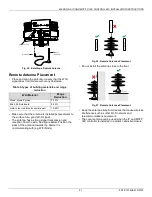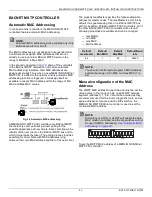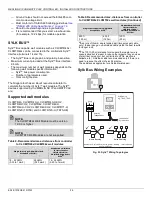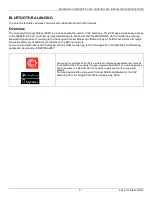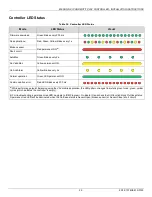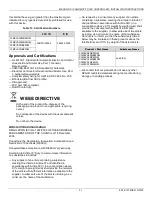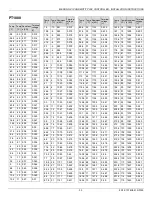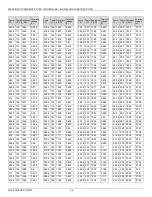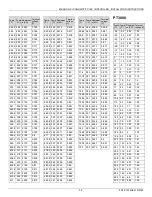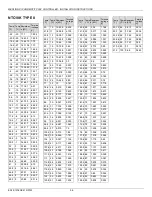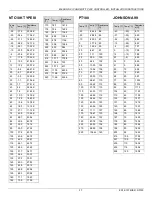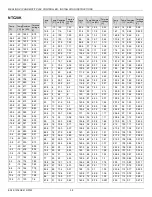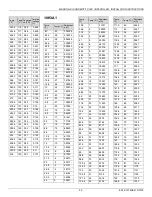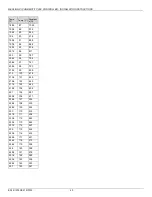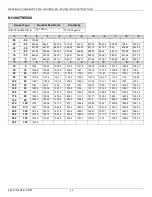
MERLIN NX IP AND MST/TP VAV CONTROLLER - INSTALLATION INSTRUCTIONS
EN1Z-1076GE51 R0722
32
APPENDIX
Sensor Input Accuracy
The controller's internal sensor inputs support both
NTC10K
Ω
and NTC20k
Ω
sensors. The following table lists
the typical minimum accuracies of the hardware and
software for these temperature sensors.
NOTE:
This is the accuracy of the internal sensor input
(ha software [linearization]), only. This table
does not include the characteristics of the sensors,
themselves (see section “Sensor Characteristics
below). If a different sensor or sensor accuracy is
required, one may instead use the inputs of, such as
a connected Panel I/O module.
Recognition of Sensor Failure of
Sensor Inputs
The thresholds at which sensor failures – i.e., sensor
breaks (SB) and short-circuits (SC) – are recognized
depends upon the given sensor type. In the event of a
recognized sensor failure, the sensor assume the safety
internal NTC10k Ω and NTC20k Ω sensor inputs of the
lists the measurement ranges and
the corresponding thresholds for the recognition of sensor
failure for the various different sensor types:
NOTE:
In the case of temperatures lying outside the afore
-
mentioned ranges, the lowest/highest value within
the range, instead, will be communicated. Thus, a
temperature of -51 °F will be communicated as “-50
°F.”
SENSOR CHARACTERISTICS
The characteristics (resistance in relation to temperature) of
the sensors and the resultant voltage are listed on the
following pages. The stated values do not include failures
due to sensor failures; wiring resistance or wiring failures;
misreadings due to a meter connected to measure
resistance or voltage at the input.
Table 14.
Accuracies of internal NTC10k
Ω
and NTC20k
Ω
sensor inputs of the controller
Range
Measurement error (excluding
sensor characteristics)
N
TC
10
k
Ω
(a
N
TC
20
k
Jo
hn
so
n
A
99
(b
PT
30
00
N
I1
00
0T
K
50
00
(b
-50 °C to -20 °C
(-58 °F to -4 °F)
≤ 5.0 K ≤ 5.0 K
≤ 1.2 K ≤ 1.2 K ≤ 1.2 K
-20 °C to 0 °C
(-4 °F to +32 °F) ≤ 1.0 K ≤ 1.0 K
≤ 0.7 K ≤ 0.7 K ≤ 0.7 K
0 °C to 30 °C
(32 °F to 86 °F)
≤ 0.5 K ≤ 0.3 K
≤ 0.5 K ≤ 0.5 K ≤ 0.5 K
30 °C to 70 °C
(86 °F to 158 °F) ≤ 0.5 K ≤ 0.5 K
≤ 0.7 K ≤ 0.7 K ≤ 0.7 K
70 °C to 100 °C
(158 °F to 212 °F) ≤ 1.0 K ≤ 1.0 K
≤ 1.2 K ≤ 1.2 K ≤ 1.2 K
100 °C to 130 °C
(212 °F to 266 °F) --
≤ 3.0 K
≤ 1.2 K ≤ 1.2 K ≤ 1.2 K
130 °C to 150 °C
(266 °F to 302 °F) --
≤ 5.5 K
≤ 1.2 K ≤ 1.2 K --
150 °C to 400 °C
(302 °F to 752 °F) --
--
--
--
--
(a
NTC10k
Ω
specified for -30 °C to +100 °C (-22 °F to 212 °F)
only.
(b
Johnson A99 specified for -40 °C to +120 °C (-40 °F to +248
°F) only.
(c
NI1000TK5000 specified for -30 °C to+130 °C (-22 °F to +266
°F) only.
Table 15. Thresholds for short-circuit (SC) and sensor-
break (SB) recognition
I/O configuration Measurement range Recognition thresholds
2 to 10 V
2to10 V / 4to20 mA
(without pull-up)
SC: < 1.5 V / 3 mA;
SB: no recognition
NTC10k
Ω
(Type II) -30 °C to +100 °C
(-22 °F to +212 °F)
SC: < 20
Ω
;
SB: < -94 °F (-70 °C)
NTC20k
Ω
-50 °C to +150 °C
(-58 °F to +302 °F)
SC: < 20
Ω
;
SB: < -94 °F (-70 °C)
PT1000
-50 °C to + 400 °C
(-58 °F to +752 °F)
SC: < 775
Ω
;
SB: < -58 °F (-50 °C)
Ni1000TK5000
-30 °C to +130 °C
(-22 °F to +266 °F)
SC: < 850
Ω
;
SB: < -58 °F (-30 °C)
PT100
-50 °C to +400 °C
(-58 °F to +752 °F) -
PT3000
-50 °C to +150 °C
(-58 °F to +302 °F) -
10K3A1
-40 °C to +125 °C
(-40 °F to +257 °F) -
Nickel Class B DIN
43760
sensors
-60 °C to +169 °C
(-76 °F to +752 °F) -
JOHNSON A99
-40 °C to +120 °C
(-40 °F to +248 °F) -




